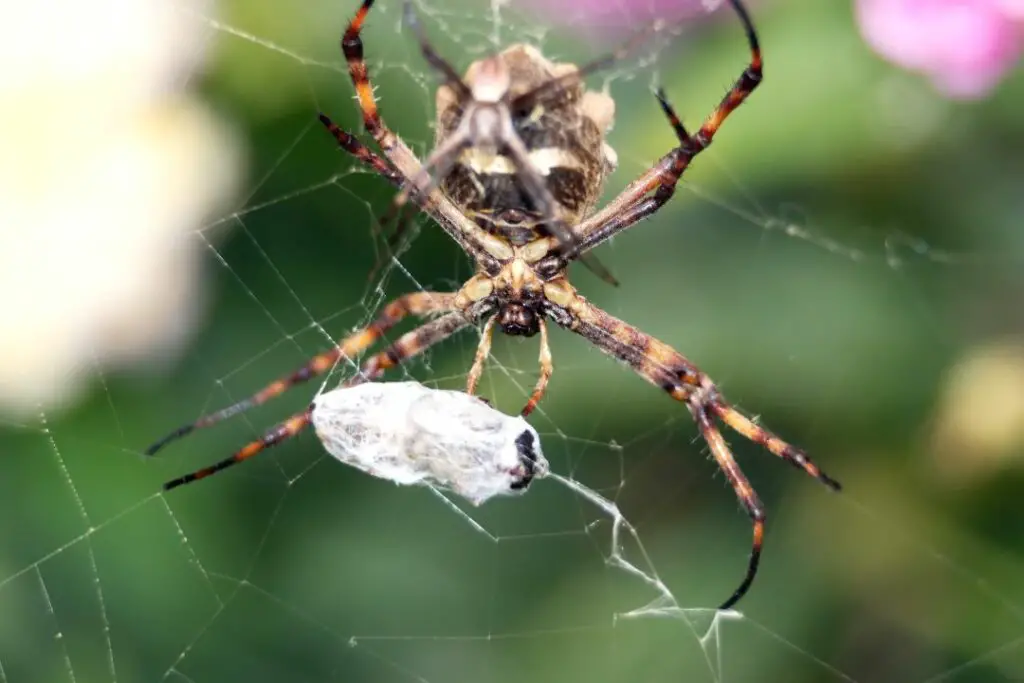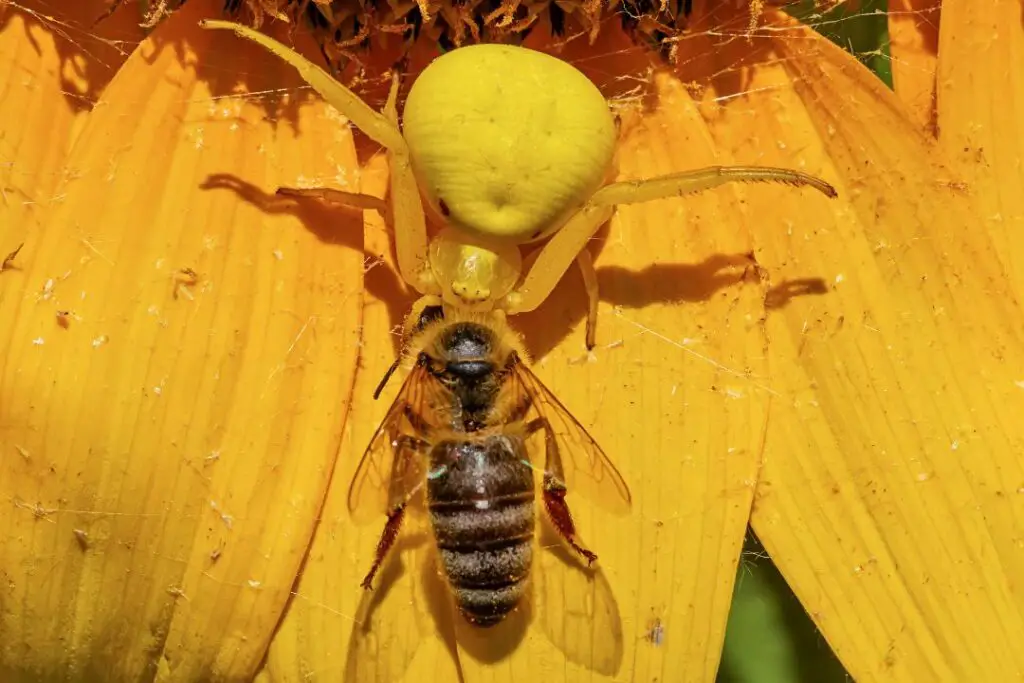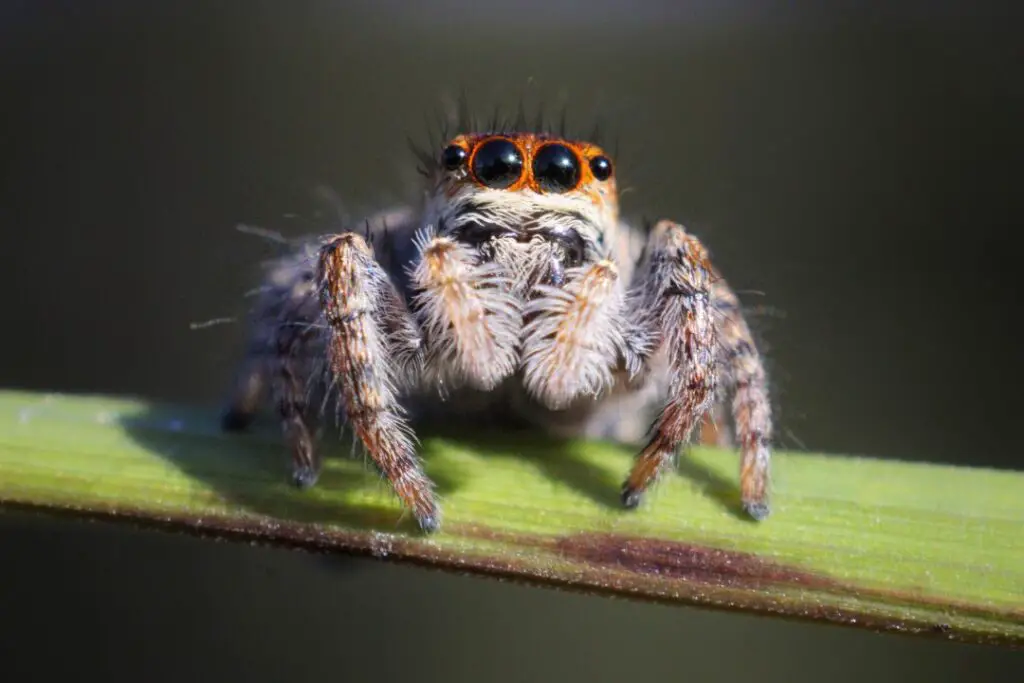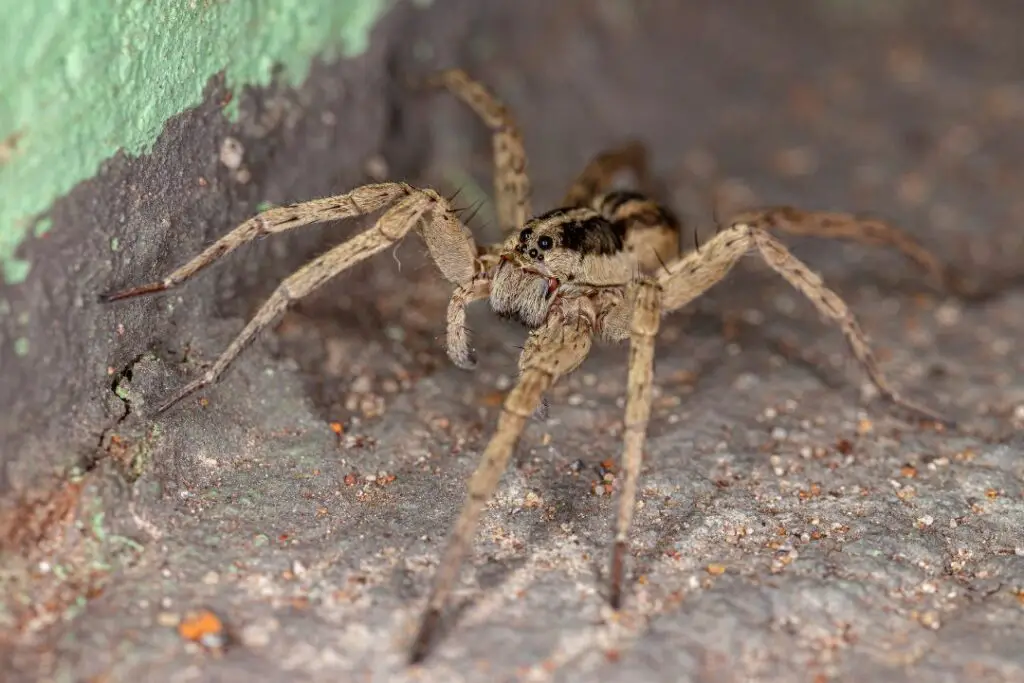Yes, some spiders do eat bees. Orb-weavers, jumping, wolf and crab spiders will all hunt and consume any unfortunate bees that cross their path.
Spiders are some of the best garden predators. They use a lot of different methods to catch and kill their prey.
Bees and spiders – two small critters that often cross paths in backyards and gardens. But do bees actively hunt and eat spiders, or are they just incidental prey caught in webs? Let’s explore the diet, behaviors, and interactions between bees and spiders
What Do Bees Eat?
Bees are specialized feeders that gather plant-based foods, Their primary diet consists of
-
Pollen – Bees collect pollen from flowers and transport it back to their nests. Pollen provides protein, fats, vitamins, and minerals. Worker bees eat some pollen and mix the rest with nectar to feed larvae.
-
Nectar – Bees sip nectar from flowers, stored internally in a special stomach called the crop. Back at the hive, nectar is regurgitated and dehydrated into honey for long-term storage. Nectar gives bees carbohydrates.
Foraging worker bees spend hours flying from flower to flower, collecting pollen and nectar. They don’t pursue other insects as food sources.
Do Spiders Eat Bees?
Yes, some spider species regularly catch and eat bees. Bees become stuck in webs or are ambushed by spiders that don’t spin webs. Common bee-eating spiders include:
-
Orb weavers – Build large, intricate circular webs to trap flying insects. Any pollinator caught in an orb web may become spider prey.
-
Crab spiders – Camouflaged spiders that ambush visiting bees from inside flowers. They inject bee prey with venom and digestive enzymes to liquify the internal organs.
-
Jumping spiders – Actively hunt by jumping on insects. Some jumping spiders stalk bees gathering pollen and nectar on plants.
-
Spider wasps – Hunt spiders to provide food for their larvae. They paralyze spiders by stinging then carry them back to their ground nest.
However, bees aren’t a primary food source for most spiders. Spiders are opportunistic generalists, eating any appropriately sized insect they can capture.
Do Bees Hunt and Eat Spiders?
No, bees do not purposefully hunt spiders or other insects to eat. As mentioned above, bees are specialized pollen and nectar feeders.
But bees sometimes inadvertently transport spiders back to the hive. This occurs when foraging bees accidentally pick up hitchhiking spiders on their fuzzy bodies. Bringing spiders into the close quarters of a hive puts bees at risk.
How Do Bees Defend Against Spiders?
Bees have developed special tactics to keep spiders out of hives where they pose a threat:
-
Vigilant guard bees stationed at the hive entrance inspect incoming foragers and remove any spiders clinging to them. They may bite or sting intruders.
-
Propolis, a sticky resin collected by bees, is used to seal small gaps in the hive that spiders could squeeze through.
-
When attacked by spiders outdoors, bees may ball them, surrounding the threat with a mass of bodies and vibrating wing muscles to produce heat.
-
If bees detect a breach letting spiders into the hive, they may abscond and quickly abandon that site for a new nest location.
Examples of Bees Caught by Spiders
-
Black and yellow mud dauber wasps are sometimes captured in orb weaver webs. These wasps resemble bees but prey on spiders and don’t produce honey.
-
Bumble bees foraging in thick vegetation may blunder into concealed crab spiders waiting unseen inside flowers.
-
Jumping spiders pounce on heavy-bodied carpenter bees as they visit flowers, overpowering them with the element of surprise.
-
Cuckoo bees, lacking defensive barbs on their stingers, are more vulnerable to being trapped in webs compared to honey bees.
Can Bees and Spiders Coexist?
Absolutely! Both fill important ecological roles. Bees are essential plant pollinators. Spiders control insect pests and cycle nutrients back into the soil and plants via decomposition.
A diverse landscape with flowering plants benefits bees while providing alternative prey to divert spiders. Avoiding broad-spectrum insecticides preserves the balance between predator and prey. With thoughtful practices, gardens and fields can sustain both of these helpful arthropods.
Which Spiders Eat Bees?
Let’s meet some garden spiders who will happily snack on an unsuspecting bumblebee if given the chance.
Check out our list of animals that eat bees to meet some other garden hunters.

Appearance: Vibrant and intricate, with a patterned abdomen and long, slender legs.
Nature’s master weaver. These guys spin intricate webs often found between plants. They’re like the fishers of the spider world.
They cast their nets (webs, in this case) and lie in wait. It’s dinner time when a bee, fly, or moth gets caught.
Sticky threads entangle the prey. As it struggles, vibrations run up the threads, alerting the resident spider.
In an instant, the spider quickly moves to kill its prey with a terrifying bite that delivers its poison.
This venom immobilizes the bee and breaks down its insides nearly immediately.
That’s it! The Orb Weaver can eat its well-earned meal or spin it in silk for a later snack.

Appearance: Mimicry masters, often coloured white or yellow like the flowers they hide in, with crab-like legs.
This spider’s secret weapon is its incredible ability to blend in. Their bright yellow colouring means they can camouflage themselves against flower petals and fruit.
When an unsuspecting bee lands in a hunt for nectar and pollen, the trap is set.
These ambush predators stay completely still until the bee moves within striking range. Instantly, it wraps its front legs around the bee and sinks its mandibles into the insect’s body.
Once captured, the Crab Spider’s venomous bite will quickly paralyze its victim, ready to be consumed.
But what makes it really cool is that it can reflect UV rays, which are what bees use to find flowers with lots of nectar.
So, flowers with crab spiders waiting are a lot more likely to get bees and other insects that don’t know it.
The video below shows a Flower Crab Spider in ambush stance, waiting for its next meal.

Appearance: Small and furry, with large, forward-facing eyes that lend them a cute appearance.
This species doesn’t spin webs. Instead, it stalks its prey before leaping into action.
Even though they are very small (no more than 15 mm in length), they have the best eyesight of all spider species.
They use this incredible vision to spot prey like wasps and bees.
Once locked on, they use their powerful hind legs to launch at their target with staggering speed.
By biting the bee with their poisonous fangs, they knock it out and let the spider eat it without worrying about a fight.
After the bee is immobilized, the jumping spider typically retreats to a safe location to consume its prey.
Like other spiders, it will suck the bee’s liquid insides out because its poison does the digestion work.

Appearance: Earthy hues of brown or grey, with robust bodies and a camouflage pattern, often mistaken for tarantulas.
These ground-dwelling hunters stalk their prey with cunning and agility, nothing short of extraordinary.
The Wolf Spider doesn’t rely on a silky trap. Using its excellent vision and fast reflexes to hunt, it relies on speed above everything else.
Once the wolf spider detects a bee, the drama unfolds.
It stalks its prey carefully, moving closer until it’s within striking distance. Then, with an explosive burst of speed, it pounces!.
This spider hunts by itself and has skills as sharp as its fangs. It is often found in homes and neighborhoods looking for food.
Do Bees Ever Eat Spiders?
No, no known species of bees actively hunt and consume spiders. Bees are primarily herbivores. They feed on nectar and pollen from flowers.
They’re not built for hunting; they aim to collect food to return to the hive.
Bee vs. Jumping Spider | National Geographic
FAQ
Will bees attack spiders?
Who eats the spider?
Can a spider catch a bee?
Do spiders attract bees?
Do spiders eat bees?
Yes, spiders will eat bees if they can catch them. For example, it’s not uncommon to see bees caught in spider webbing. Some types of spiders, such as crab spiders, are known for ambushing bees. —> Go back to the FAQs on “What Eats Bees?” Can I Put Baking Soda on Bee Stings? Do Wasps Make Honey? Do Yellowjackets Make Honey or Honeycomb?
Can a spider bite kill a human?
Most spider bites are not dangerous and do not pose a significant threat to humans. The majority of spiders are not venomous or have venom that is not potent enough to harm humans. However, certain spider species, like the black widow and brown recluse spiders in specific regions, have venom that can cause more severe reactions. Although the risk of a spider bite becoming life-threatening is low, in rare cases, a severe allergic reaction or a serious infection may occur. It’s essential to seek medical attention if you suspect a venomous spider bite or experience severe symptoms. To reduce the risk of spider bites, avoid handling or provoking spiders, and take precautions in areas where spiders may be present. If bitten, seek prompt medical attention for proper evaluation and treatment.
Do crab spiders eat bees?
The guest of course is dinner, something I need to think on, since I’ve had many guests I’d rather eat than feed. Like other bee predators, crab spiders are not choosy when it comes to species. They will take most any kind of bee as well as flies, beetles, moths, and butterflies.
How do spiders eat insects?
Some spiders spin sticky webs, which entangle insects. The spider then moves in, sometimes biting the wasp or bee, injecting a chemical that will paralyze the insect, before they cover them in silk webbing to eat at their convenience. There are also ambush spiders, that lie in wait in plants and on flowers for pollinating insects to lend.
Can bees kill spiders?
Bees can and will kill spiders if they threaten the hive or nest. They rely on sheer numbers to overwhelm and repeatedly sting the intruder. While spiders have no trouble dispatching a single bee, this mass assault is a very different story.
Can bees get caught in a spider’s web?
This is no different for bees getting caught in a spider’s web. There are some sneaky spiders, referred to as flower crab spiders, that hideout amongst bees’ favorite flowers hoping to catch their prey off guard. These spiders can even change color, camouflaging them against the flower they are hunting from.
